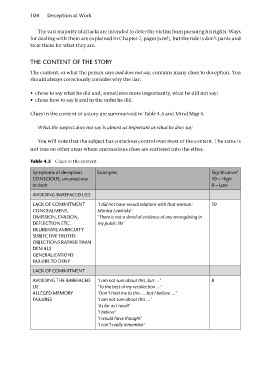Page 63 - Deception at work all chapters EBook
P. 63
104 Deception at Work
The vast majority of attacks are intended to deter the victim from pursuing his rights. Ways
for dealing with them are explained in Chapter 7, pages [xref], but the rule is don’t panic and
treat them for what they are.
THE CONTENT OF THE STORY
The content, or what the person says and does not say, contains many clues to deception. You
should always consciously consider why the liar:
• chose to say what he did and, sometimes more importantly, what he did not say;
• chose how to say it and in the order he did.
Clues in the content of a story are summarized in Table 4.5 and Mind Map 5.
What the suspect does not say is almost as important as what he does say
You will note that the subject has conscious control over most of the content. The same is
not true on other areas where unconscious clues are scattered into the ether.
Table 4.5 Clues in the content
Symptoms of deception Examples Significance3
CONSCIOUS, unconscious 10 = High
or both 0 = Low
10
AVOIDING BAREFACED LIES
8
LACK OF COMMITMENT ‘I did not have sexual relations with that woman:
CONCEALMENT, Monica Lewinsky’
OMISSION, EVASION, ‘There is not a shred of evidence of any wrongdoing in
DEFLECTION ETC. my public life’
DELIBERATE AMBIGUITY
SUBJECTIVE TRUTHS
OBJECTIONS RATHER THAN
DENIALS
GENERALIZATIONS
FAILURE TO DENY
LACK OF COMMITMENT
AVOIDING THE BAREFACED ‘I am not sure about this, but …’
LIE ‘To the best of my recollection …’
ALLEGED MEMORY ‘Don’t hold me to this … but I believe …’
FAILURES ‘I am not sure about this …’
‘As far as I recall’
‘I believe’
‘I would have thought’
‘I can’t really remember’

